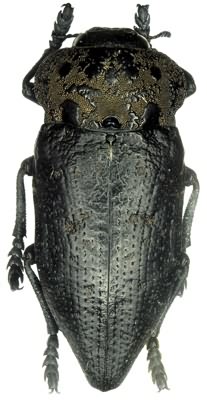Pests
Capnodis tenebrionis (L.). - Peach Flatheaded Rootborer
Systematic position.
Class Insecta, order Coleoptera, family Buprestidae, genus Capnodis Eschscholtz.Synonyms.
Buprestis variegata Goeze, B. tenebrioides Pall., B. naevia Gmelin, B. moluccensis Voet.Biological group.
Pest of stone-fruit plantations.Morphology and biology.
Body length, 14-28 mm. Integument is almost bare, black, sometimes with bronze shine. Frons slightly longitudinally concave, sparsely covered with large punctures. Antennae short, with transversal apical segments, not reaching to fore coxae. Pronotum transversal, somewhat wider than elytra. Pronotal sculpture comprises dense punctation with several large and numerous small smooth spots. Pronotal surface around basal excavation is punctured. Elytra are cuneiform, narrowed toward slightly attenuated apex. Elytral striae are distinct, consisting of elongated punctures. Adults fly very well.Distribution.
Middle and South Europe, Northern Africa, Turkey, Near East, Iran. In the former USSR, the species inhabits the southern European part including Moldova, southern Ukraine, Ciscaucasia, the Caucasus, Lower Volga region, Western Kazakhstan, Turkmenistan.Ecology.
Generation development lasts about 3 years. Larvae and adults hibernate. Adults appear in April or in the beginning of May and start feeding. The species is thermophilic; the optimal air temperature is about 28-33°C. Oviposition starts in June and lasts about 2 months. Female lays eggs on litter, root collars, into the soil cracks, preferring dry sites. Embryonal development lasts about 10-20 days. After hatching, larvae penetrate into roots of apricot, peach, plum, cherry, and cherry-plum for development. They hibernate 2 times; mature larva is 6.5-8.5 cm in length. Pupation occurs at the end of spring or in June; pupa development lasts 3-5 weeks. Young adults feed until winter diapause begins. Oviposition starts the next year only. Fertility of female is about 300 or more eggs in Armenia. Most adults die in autumn, after the end of oviposition; their small part hibernates twice. C. tenebrionis occurs in mountains up to 1600 m above sea level; wild blackthorn bush is its natural reservation.Economic significance.
Larvae and adults damage saplings and young stone-fruit cultures. Adults devour cortex, leafstalks, and fruit buds. Orchard bushes lose their leaves after C. tenebrionis mass abundance. Economic significance is greater in southern arid regions, especially in Eastern Georgia, Armenia and Azerbaijan. Irrigation of orchards during oviposition period is one of the pest control measures because it destroys most eggs.Reference citations:
Arakel'yan A.O. 1954. Study of the biology of Capnodis tenebrionis L. and elaboration of the control measures. PhD Thesis. Erevan: Plant Protection department of AS Arm.SSR, 26 p. (in Russian).Batiashvili I.D. 1959. Pests of continental and subtropical fruit crops. Tbilisi: Institut sel'skogo khozyaistva, 455 p. (in Russian).
Ben-Yehuda S., Assael F. & Mendel Z. 2000. Improved chemical control of Capnodis tenebrionis and C. carbonaria in stone-fruit plantations in Izrael. Phytoparasitica 28 (1): 1-16.
Panshin I.A. 1952. Capnodis tenebrionis L. is a pest of apricot in Stalingrad Region. In: Preobrazhenskii A.Yu., ed. Proceedings of Stalingrad SKhI. V. 2. Stalingrad: Obl. knigoizd., p. 126-135 (in Russian).
Rikhter A.A. 1944. Review of buprestid beetles of the European part of the USSR (Coleoptera, Buprestidae). Zoological proceedings (3). Erevan: AS Arm SSR, p. 131-176 (in Russian).
Rikhter A.A. 1952. Buprestid beetles (Buprestidae). Insecta - Coleoptera. Fauna of the USSR. V. 13. 4 (4). Moscow & Leningrad: AN SSSR, 234 p. (in Russian).
Samedov N.G. 1963. Fauna and biology of the beetles injuring agricultural plants in Azerbaijan. Baku: AN Azerb.SSR. 384 p. (in Russian).
Vasil.ev V.P. & Livshits I.Z., 1958. Pests of fruit crops. Moscow: Sel.khozlit. 392 p. (in Russian).


